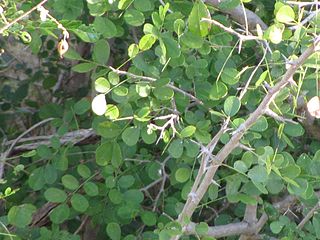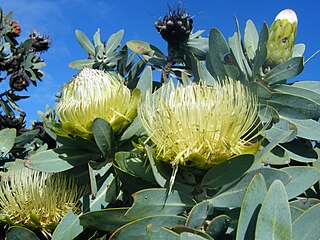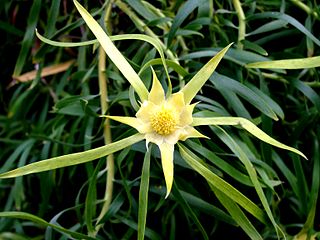
Jacaranda mimosifolia is a sub-tropical tree native to south-central South America that has been widely planted elsewhere because of its attractive and long-lasting violet-colored flowers. It is also known as the jacaranda, blue jacaranda, black poui, Nupur or fern tree. Older sources call it J. acutifolia, but it is nowadays more usually classified as J. mimosifolia. In scientific usage, the name "jacaranda" refers to the genus Jacaranda, which has many other members, but in horticultural and everyday usage, it nearly always means the blue jacaranda.

Dalbergia melanoxylon is a flowering plant in the family Fabaceae, native to seasonally dry regions of Africa from Senegal east to Eritrea and south to the north-eastern parts of South Africa. The tree is an important timber species in its native areas; it is used in the manufacture of musical instruments and fine furniture. Populations and genomic resources for genetic biodiversity maintenance in parts of its native range are threatened by overharvesting due to poor or absent conservation planning and by the species' low germination rates.

The wildlife of South Africa consists of the flora and fauna of this country in southern Africa. The country has a range of different habitat types and an ecologically rich and diverse wildlife, vascular plants being particularly abundant, many of them endemic to the country. There are few forested areas, much savanna grassland, semi-arid Karoo vegetation and the fynbos of the Cape Floristic Region. Famed for its national parks and big game, 297 species of mammal have been recorded in South Africa, as well as 858 species of bird and over 20,000 species of vascular plants.

Widdringtonia wallichii, Clanwilliam cedar or Clanwilliam cypress, previously Widdringtonia cedarbergensis is a species of Widdringtonia native to South Africa, where it is endemic to the Cederberg Mountains northeast of Cape Town in Western Cape Province. It is threatened by habitat loss and protected in South Africa under the National Forest Act of 1998.

The dapple-throat is a species of bird in the small African family Modulatricidae. Other common names include dappled mountain robin and dappled mountain greenbul. It is native to Mozambique and Tanzania. This is the only species in the monotypic genus Arcanator.

The tree hyrax or tree dassie is a small nocturnal mammal native to Africa. Distantly related to elephants and sea cows, it comprises the four species in the genus Dendrohyrax, one of only three genera in the family Procaviidae, which is the only living family within the order Hyracoidea.

Faurea is a genus containing 16 species of flowering plants in the protea family which occur in the summer rainfall area of southern Africa, extending to tropical Africa and Madagascar. The name honours South African soldier and botanist William Caldwell Faure (1822-1844) who was killed on active service in India.

Protea comptonii, also known as saddleback sugarbush, is a smallish tree of the genus Protea in the family Proteaceae. It is found in South Africa and Eswatini.

Faurea saligna is a graceful, semi-deciduous tree of the family Proteaceae growing to about 10 metres, or up to 20 metres under forest conditions. Found from tropical Africa south to the Transvaal, Swaziland and Natal, often in large communities on sandy soil and along stream beds.

Protea nitida, commonly called wagon tree, waboom or blousuikerbos, is a large, slow-growing Protea endemic to South Africa. It is one of the few Protea species that grows into trees, and the only one that has usable timber.

Protea lacticolor or the Hottentot sugarbush, Hottentot white sugarbush or Hottentot's Holland sugarbush, is a flowering shrub of the Protea genus. It is also known as the Hottentotwitsukkerbos. The plant is endemic to South Africa and is found from the Slanghoek to the Hottentots Holland Mountains and also the Groenlandberg.

Faurea galpinii is a small tree that grows to 10 m tall, but its trunks will vary depending on growing conditions. The leaves of F. galpinii are alternately lanceolate with wavy margins. When growing in the forest, the bark appears grey with smooth, concentric rings, although it can appear rough and dark under exposed conditions, and the variety Faurea gal pinii varies in size from 1 m to 2 m.
Leucadendron ericifolium, the erica-leaved conebush, is a flower-bearing shrub that belongs to the genus Leucadendron and forms part of the fynbos. The plant is native to the Western Cape, South Africa.

Leucadendron eucalyptifolium, the gum-leaved conebush, is a flower-bearing shrub belonging to the genus Leucadendron and forms part of the fynbos. The plant is native to the Western Cape and the Eastern Cape, where it occurs in the Potberg, Riversdal Plains, Langeberg, Outeniqua Mountains, Tsitsikamma Mountains, Kouga Mountains, Elandsberg, Swartberg, Waboomsberg, Warmwaterberg, Touwsberg, Rooiberg and Soetwaterberg. The shrub grows 4 m tall and bears flowers from July to October.

Paranomus bracteolaris, the smooth-leaf tree sceptre or Bokkeveld sceptre, is a flower-bearing shrub that belongs to the genus Paranomus and forms part of the fynbos. The plant is native to the Western Cape and Northern Cape, South Africa.

Paranomus roodebergensis, also known as the honey-scented sceptre, is a flower-bearing shrub that belongs to the genus Paranomus and forms part of the fynbos. The plant is native to the Western Cape, South Africa.

Paranomus tomentosus, the hairy-leaf tree sceptre, is a flower-bearing shrub that belongs to the genus Paranomus and forms part of the fynbos. The plant is native to the Western Cape, South Africa.

Faurea rochetiana, also known as the broad-leaved beechwood, is a tree found in much of Africa from Sudan south to Limpopo, Mpumalanga and northern KwaZulu-Natal. The tree is small and leafy. It has wider leaves, larger flowers and flower veins and also denser hairy twigs than the bushveld beechwood. The tree's national number is 76.
Faurea recondita, also known as the Kamdeboo beechwood, is a tree that forms part of the genus Faurea. It occurs in the Kamdeboo Mountains. The species was only identified in 2013 after it was discovered in 2008. The tree grows on average two metres high. It has many similarities with Faurea coriacea found in Madagascar.


















